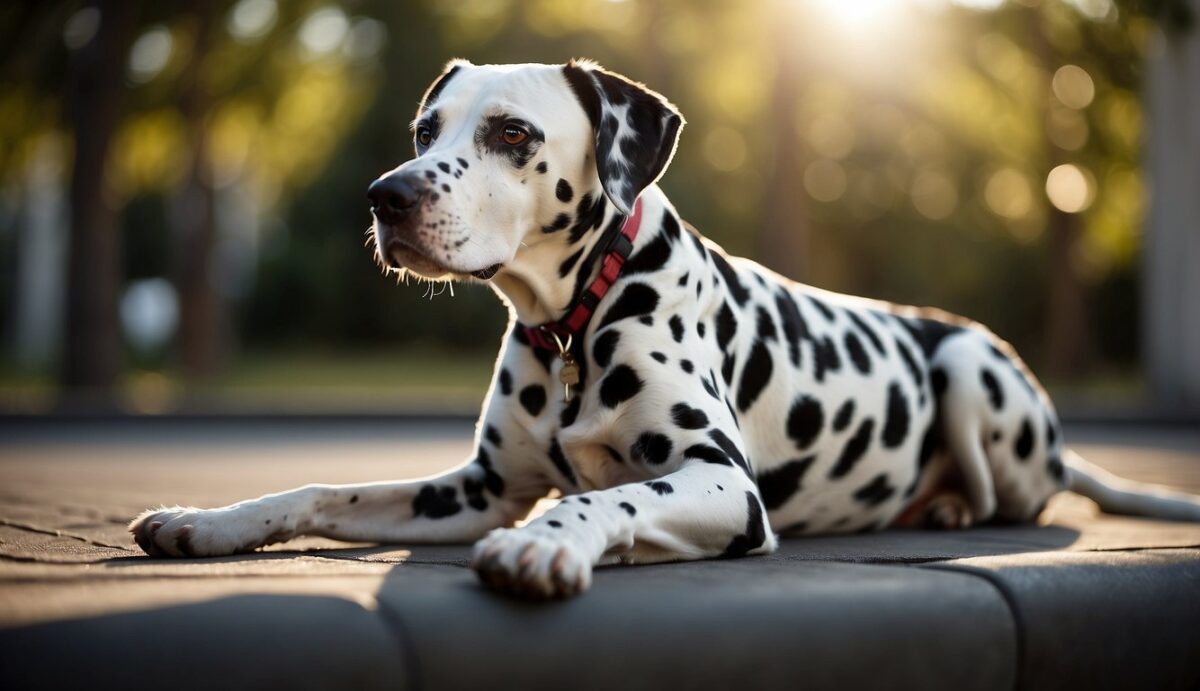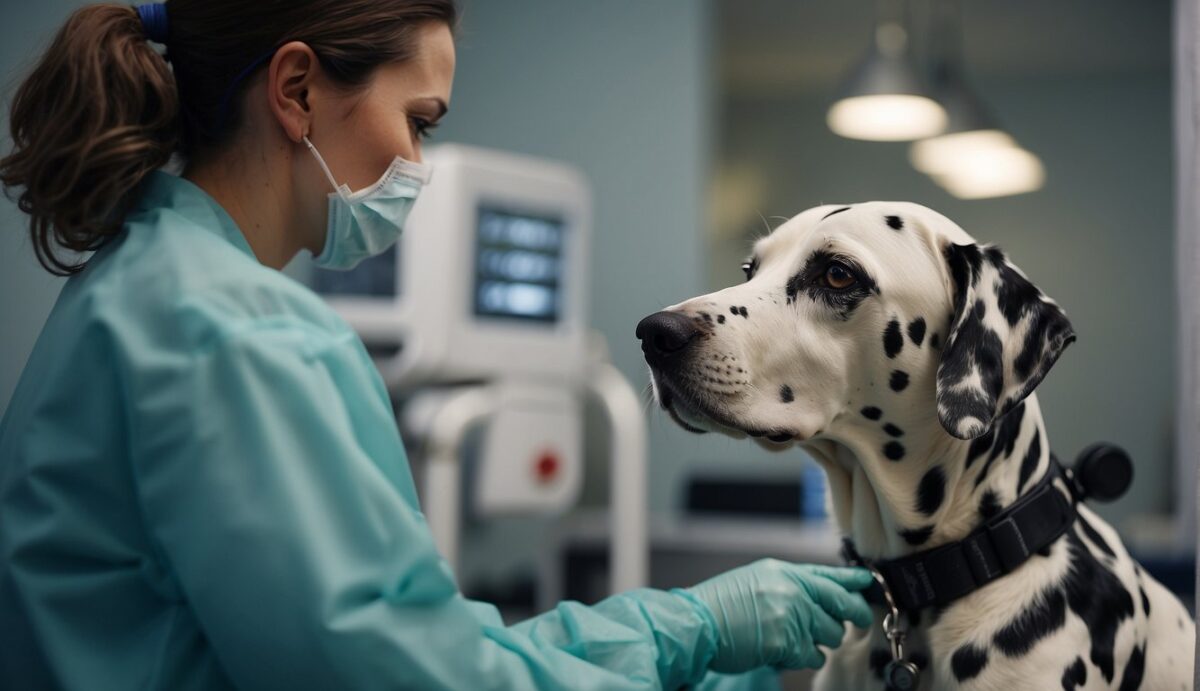Dalmatian spinal health is an important aspect of the overall well-being of these distinctive and active dogs.
With their characteristic spots and energetic disposition, Dalmatians are a breed that can bring a lot of joy to their owners. However, they can be susceptible to certain spinal issues, such as degenerative myelopathy, which is a progressive disease of the spinal cord typically presenting as a loss of coordination in the hind limbs.
Understanding the signs, prevention strategies, and treatment options for spinal problems is crucial for maintaining the health and happiness of a Dalmatian.
While genetics can play a role in the occurrence of certain spinal issues in Dalmatians, environmental factors and overall health also influence the integrity of a dog’s spine.
Regular checkups with a veterinarian, a well-balanced diet to maintain healthy weight, and appropriate exercise to strengthen the musculature supporting the spine are all proactive measures that can contribute to preventing back problems.
When treatment is required, options can vary based on the condition and severity, ranging from medication to manage symptoms to physical therapy or even surgery for more serious cases.
Key Takeaways
- Recognize early signs of spinal problems in Dalmatians to ensure prompt treatment.
- Support your Dalmatian’s spinal health with regular veterinary care and proper exercise.
- Treatment for spinal issues can include medication, physical therapy, and sometimes surgery.
Keeping Your Dalmatian Healthy

Ensuring the health and happiness of your Dalmatian involves a combination of physical care and love.
Your attention to their exercise routines, diet, regular medical check-ups, and grooming plays a crucial part in preventing spinal issues and maintaining overall wellness.
Importance of Regular Exercise
Regular exercise is key to your Dalmatian’s spinal health.
Aim for at least 30 to 60 minutes of physical activity each day. Include activities that promote balance and strengthen muscles without putting too much strain on the back. Avoid high-impact exercise to prevent joint and spinal stress.
- Walking: Daily walks for muscle strength and joint health
- Swimming: Low-impact exercise for high energy dogs
- Controlled play: Keeps your Dalmatian agile without overexertion
Proper Diet and Nutrition
Your Dalmatian’s diet should be rich in nutrients that support spinal health and muscle maintenance.
- Balanced diet: Consist of proteins, carbohydrates, fats, vitamins, and minerals
- Protein: Supports muscle development and repair
- Calcium and phosphorus: Maintain bone health
- Omega-3 fatty acids: For joint mobility and anti-inflammatory effects
Feed your dog high-quality dog food and incorporate treats only as occasional rewards to prevent obesity, which can strain the spine.
Routine Veterinary Care
Regular veterinary check-ups can catch early signs of spinal issues and other health problems.
- Annual physical examinations: Including spine checks
- Vaccinations: To prevent diseases that can weaken overall health
- Dental care: Good oral hygiene impacts overall health
Discuss any concerns, especially those involving your Dalmatian’s mobility and back health, with your vet.
Health and Grooming
Grooming is more than just keeping your Dalmatian looking good – it’s an essential part of their health.
- Regular brushing: Reduces hair loss and can alert you to any skin allergies or issues
- Bathing: As necessary to remove allergens and maintain healthy skin
- Nail trimming: Keeps your Dalmatian’s posture and balance in check
Always be gentle when grooming near the spine to avoid discomfort or injury.
Dalmatian Spinal Health

To ensure your Dalmatian lives a happy, active life, understanding and maintaining their spinal health is crucial.
Pay close attention to their back’s structure, common issues, and signs of problems.
Anatomy of the Canine Spine
Your Dalmatian’s spine consists of numerous small bones called vertebrae. These vertebrae are cushioned by discs and supported by muscles and ligaments to provide flexibility and strength. The spine protects the spinal cord, the critical pathway for signals between the brain and the body. The lower back, or lumbar region, is particularly important for movement and support.
Common Spinal Health Issues
Several health problems can affect your Dalmatian’s spine:
- Degenerative Disc Disease: As Dalmatians age, intervertebral discs can deteriorate, losing their cushioning ability.
- Degenerative Myelopathy: This nervous system disorder leads to the spinal cord’s gradual degeneration, affecting signal transmission and causing mobility issues.
- Herniated Discs: Discs can bulge or herniate, potentially causing painful pressure on the spinal cord.
Monitoring for these conditions via X-rays or veterinary evaluations can be essential for early detection and treatment.
Recognizing Back Problems
Watch for these symptoms to identify potential spine issues in your pup:
- Discomfort when touched along the spine
- Reluctance to jump or climb stairs
- Changes in posture
- Difficulty with or abnormal gait during movement
These symptoms could indicate a range of issues from mild muscle strain to serious conditions requiring medical intervention. If you notice any of these signs, it’s important to consult your vet to ensure your Dalmatian receives proper care.
Treating Spinal Issues in Dalmatians

When your Dalmatian faces spinal issues, understanding the range of available treatments is crucial for helping them regain strength and mobility.
Conservative Treatments
Your first approach to treating spinal problems in your Dalmatian may involve conservative methods.
Physical therapy plays a significant role in this; it helps maintain muscle strength and can improve your dog’s balance and mobility without the need for surgery.
You may also administer anti-inflammatory medication to reduce pain and swelling associated with spinal health issues.
Here’s what a conservative treatment routine might consist of:
- Physical Therapy: Tailored exercises that focus on strengthening back muscles.
- Medication: Anti-inflammatory drugs prescribed by your vet to reduce pain and inflammation.
Surgical Options
In some cases, conservative treatments might not be enough, and surgical intervention could become necessary.
If your Dalmatian suffers from severe degenerative myelopathy or other advanced spinal conditions, surgery may offer the best chance for recovery.
Surgical treatments vary depending on the diagnosis but can include procedures to remove herniated discs or to stabilize the spine. Here are a few potential surgical options:
- Disc Removal: Eliminating herniated discs to relieve spinal cord pressure.
- Spinal Stabilization: Surgically enhancing the stability of the spine to improve function.
Rehabilitation and Recovery
After any surgical treatment, a well-structured rehabilitation plan is essential for your Dalmatian’s recovery and return to normal function.
The recovery process often includes a combination of rest, continued medication for pain management, and gradually intensifying physical therapy.
Your vet will guide you through this process, adapting the plan to your dog’s progress. Key points in rehabilitation and recovery include:
- Rest: Ensuring your Dalmatian has ample time to heal after surgery.
- Continued Medication: Using medicines to control pain and assist in the recovery phase.
- Incremental Physical Therapy: Gradual exercises to restore mobility and strengthen spinal muscles.
Frequently Asked Questions (FAQs)

This section addresses common questions about managing and treating back problems in Dalmatians, offering practical advice for your dog’s care.
What are the natural ways to alleviate back pain in dogs?
You can help alleviate back pain in your dog naturally by maintaining a healthy weight for your pet to reduce stress on the back. Also, providing a supportive orthopedic bed and using gentle massage or physical therapy techniques as recommended by a veterinarian.
What is the proper technique to pick up a dog suffering from back pain?
When lifting a dog with back pain, keep their spine aligned by placing one arm under the chest and another under the hips. This way, you can lift them gently without bending or twisting their back.
What are typical signs that a dog might be experiencing lower back pain?
Typical signs of lower back pain in dogs include difficulty jumping or climbing stairs, reduced activity, stiffness, a hunched posture, and vocalization when moving or being touched in the affected area.
Which treatments are available for dogs dealing with back pain?
Treatments for dogs with back pain range from anti-inflammatory medications prescribed by a vet to more serious interventions like surgery for herniated discs. Also, supportive therapies such as acupuncture or chiropractic care.
How can dog owners recognize signs of nerve damage in their pet’s hind legs?
Signs of nerve damage in a dog’s hind legs can include weakness, loss of coordination, dragging the feet, or an inability to stand. All of these signs warrant immediate veterinary attention.
What are the steps to take when you cannot afford IVDD surgery for your pet?
If IVDD surgery is not financially feasible, discuss alternative treatment options with your vet. These options may include medications, crate rest, or a body harness to support movement. You can also inquire about payment plans or financial assistance programs for pet care.

